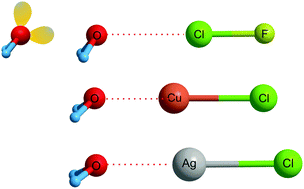当前位置:
X-MOL 学术
›
Phys. Chem. Chem. Phys.
›
论文详情
Our official English website, www.x-mol.net, welcomes your
feedback! (Note: you will need to create a separate account there.)
What's in a name?† ‘Coinage-metal’ non-covalent bonds and their definition
Physical Chemistry Chemical Physics ( IF 2.9 ) Pub Date : 2018-07-02 00:00:00 , DOI: 10.1039/c8cp03432j Anthony C. Legon 1, 2, 3, 4 , Nicholas R. Walker 4, 5, 6, 7
Physical Chemistry Chemical Physics ( IF 2.9 ) Pub Date : 2018-07-02 00:00:00 , DOI: 10.1039/c8cp03432j Anthony C. Legon 1, 2, 3, 4 , Nicholas R. Walker 4, 5, 6, 7
Affiliation

|
Many complexes of the type B⋯MX, (where B is a Lewis base such as H2, N2, ethyne, ethene, cyclopropane, H2O, H2S, PH3, or NH3, M is a coinage-metal atom Cu, Ag or Au, and X is a halogen atom) have now been characterised in the gas phase through their rotational spectra. It is pointed out that, for a given B, such complexes have angular geometries that are isomorphous with those of their hydrogen- and halogen-bonded counterparts B⋯HX and B⋯XY, respectively. Since the MX are, like the B, HX and XY referred to, closed-shell molecules, the complexes B⋯MX also involve a non-covalent bond. Therefore, the name ‘coinage-metal’ bond is suggested for the non-covalent interaction in B⋯MX, by analogy with hydrogen and halogen bonds. A generalised definition that covers all non-covalent bonds is also presented.
中文翻译:

名字叫什么?† “硬币金属”非共价键及其定义
B⋯MX类型的许多络合物(其中B是路易斯碱,例如H 2,N 2,乙炔,乙烯,环丙烷,H 2 O,H 2 S,PH 3或NH 3,M是造币金属原子Cu,Ag或Au,X是卤素原子)现在已经通过其旋转光谱在气相中进行了表征。要指出的是,对于给定的B,这种配合物的角几何分别与氢键和卤素键对应的B⋯HX和B⋯XY同构。由于MX与B,HX和XY一样是封闭壳分子,因此配合物B⋯MX也包含非共价键。因此,通过与氢键和卤素键的类比,B⋯MX中的非共价相互作用被建议使用“共金属键”。还提出了涵盖所有非共价键的通用定义。
更新日期:2018-07-02
中文翻译:

名字叫什么?† “硬币金属”非共价键及其定义
B⋯MX类型的许多络合物(其中B是路易斯碱,例如H 2,N 2,乙炔,乙烯,环丙烷,H 2 O,H 2 S,PH 3或NH 3,M是造币金属原子Cu,Ag或Au,X是卤素原子)现在已经通过其旋转光谱在气相中进行了表征。要指出的是,对于给定的B,这种配合物的角几何分别与氢键和卤素键对应的B⋯HX和B⋯XY同构。由于MX与B,HX和XY一样是封闭壳分子,因此配合物B⋯MX也包含非共价键。因此,通过与氢键和卤素键的类比,B⋯MX中的非共价相互作用被建议使用“共金属键”。还提出了涵盖所有非共价键的通用定义。










































 京公网安备 11010802027423号
京公网安备 11010802027423号